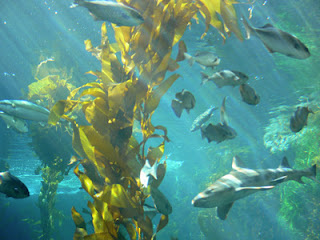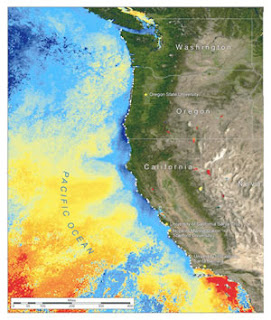Pacific Ecosystem To Experience Major Shift By 2100
Imagine waking up one day to realize that your favorite grocery store had shifted out a few miles away again? If this pattern persists, it won't take long for you to embark long trip just to feed your family. It does not make sense in our world yet but it could possibly be a not-so-distant reality for marine animals as climate change continues its threat.
A recent Nature Climate Change edition undertakes to explain how global ocean temperatures increase in the next 100 years could affect the habitat of open ocean animals in the North Pacific. While the researchers admitted that certain habitats are not likely to be severely affected, but the geographical distribution of other ocean habitats may just shift drastically, being relocated as far as 600 miles away from their current positions.
Image [Click to enlarge]
Not all animals are affected the same way. Larger creatures like blue whales, sharks and loggerhead turtles will have to face the brunt of this eminent move, but certain seabirds could stand to benefit. But the overall impact is drastic. As the natural predators are displaced from the original habitat, it could bring about irreversible changes to communities and industries on shore. For example, fisheries and ecotourism would be badly hit.
Undoubtedly, a sudden change of habitat and the time spent to migrate would be stressful for the marine life, especially those which have come under pressure due to over-fishing and other human activities. But there is also positive to pick up from here. Elliott Hazen, a researcher at National Oceanic and Atmospheric Administration, who is also an affiliate member of the Center for Ocean Solutions at Stanford suggested that if we can successfully build a model on the marine ecosystems to come, then it makes it more plausible to manage these scenarios more effectively.
The TOPP (short name for Tagging of Pacific Predators) project is central to this study. Over the last 10 years or so, it has successfully place 4,300 electronic tags on 23 species. As a result, enormous amount of data has been generated in relation to migration patterns and hotspots of certain predator species, especially around the northern Pacific region. Complex mathematical models were then applied onto these data to make sense out of it.
More data is required. Sea surface temperature and chlorophyll-a (to measure surface productivity level) were measured with the help of satellites. The tracking data is necessary so as to pinpoint "key habitat areas" for a number of predestined predator specie. Through a 'climate modeling' approach (using both ocean temperature data and productivity level), the researchers then determine the kind of changes to certain key habitat areas as the ocean continues to warm.
Image [Click to enlarge]
The North Pacific Transition Zone is one critical habitat. It is the marker between cold, nutrient-rich polar water on the north and warmer, nutrient-poor water over to the south. It represents an important corridor for various predators (marine mammals included like seabirds and tunas) to cross over to the Pacific Ocean basin. This finding revealed that the entire area could move by close to 600 miles. And the habitat move means that there is going to be a 20 % drop of species diversity.
There may be other critical habitat areas which would not as be greatly affected (if any). The California Current runs parallel to North America west coast. Each year it hosts a great deal of open ocean predators when cold, nutrient-rich water induces an environment of high productivity. Despite the threat of ocean warming, it is set to continue this so-called upwelling cycle.
Individually, those species most at risk from habitat changes (due to Pacific warming) are sharks, turtles, and marine mammals like whales. For some habitats, researchers rate their confidential level of such loss to be at a relatively high 35 %.
On the other hand, animals such as turtles and seabirds would likely gain from climate-change-related shifts. As these species have better tolerance level on temperature fluctuations, they can possible take advantage with potential expanded habitat.
Image [Click to enlarge]
It all boils down to one's adaptability to temperature change and to use multiple ocean spaces for hunting ground, according to Hazen. "Having multiple sources of food, migration corridors and areas to call home provides a buffer against climate variability and change."
The science director of the Center for Ocean Solutions, Larry Crowder, explained that modeling based on various scenarios has been employed in financial investments, national security, and whole lot of critical areas. So it is natural to use this model to identify large predators under severe threat of ocean warming, and allow us to successfully manage them. This is necessary for both commercial and conservation purposes. Crowder is involved in the study as well.
Indeed, the modeling would lend us glimpses on the impact of climate change on ocean life, so that marine and coastal managers may be able to react or change track accordingly.






Comments
Post a Comment